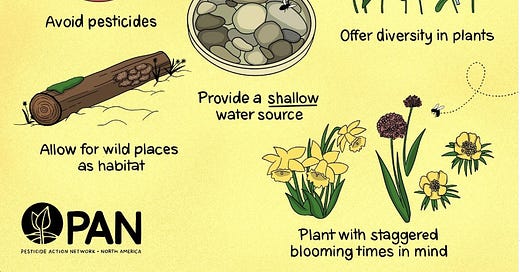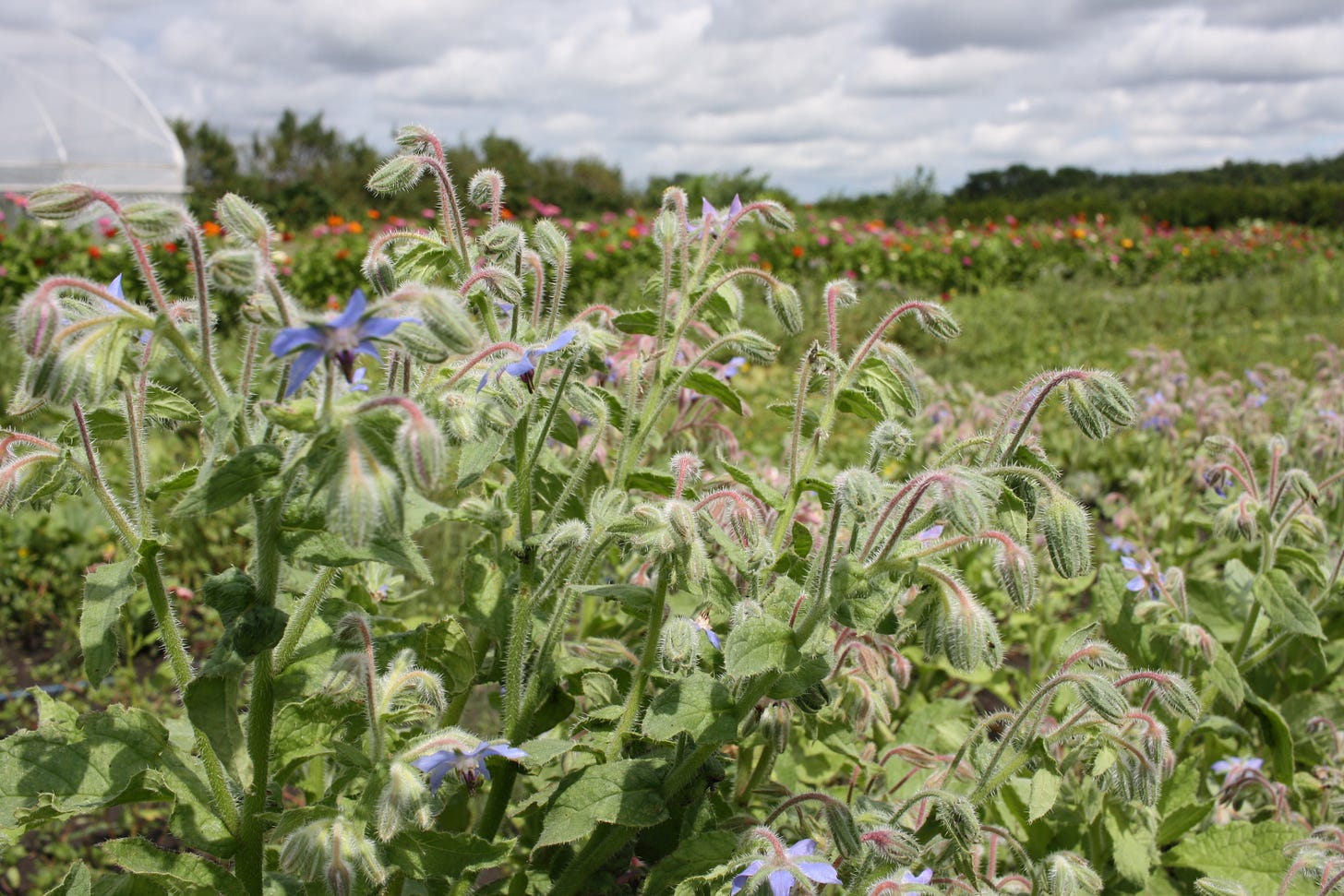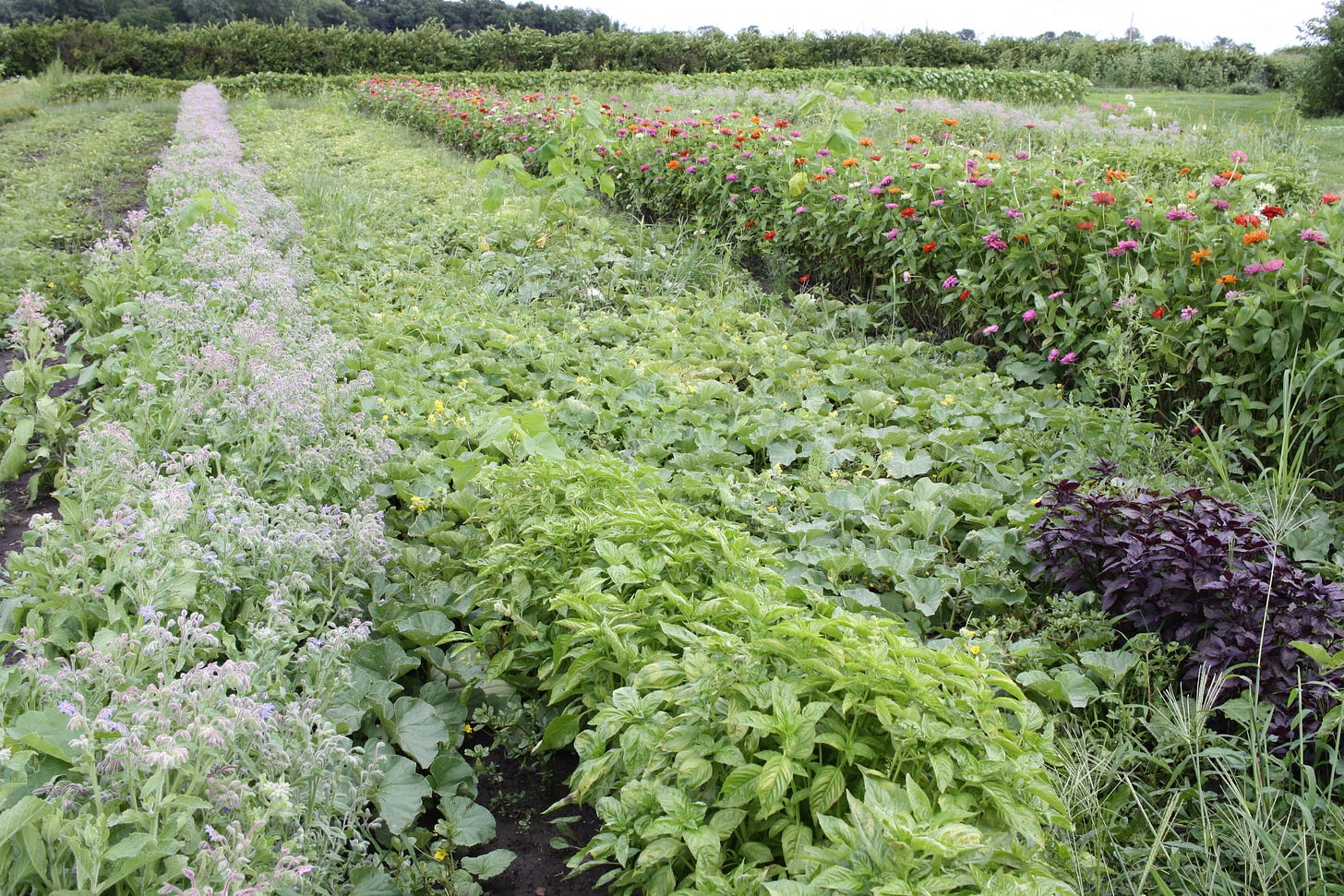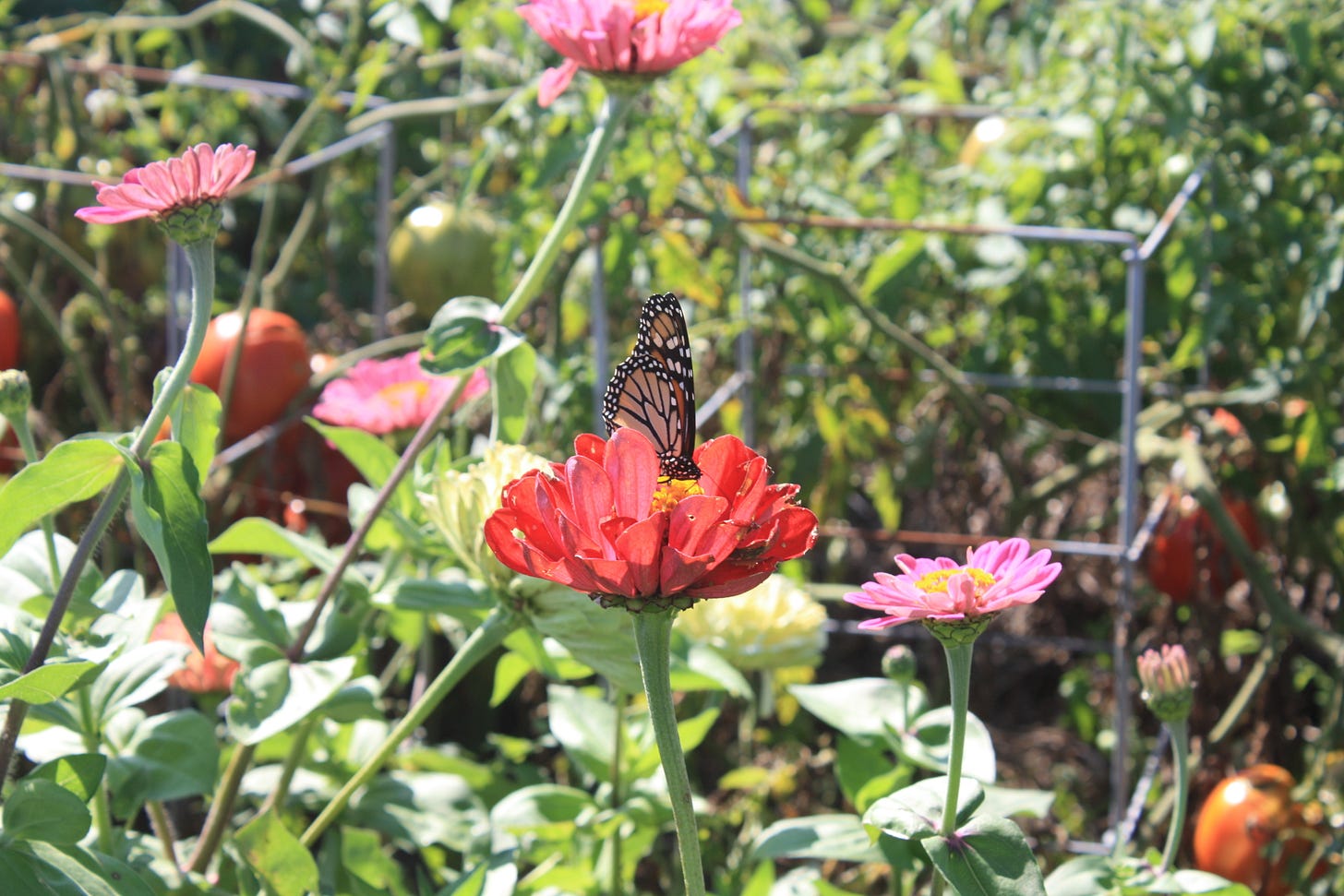Tammy and I are committed to providing a diverse and healthy habitat for pollinators on our farm. We delight in seeing all kinds of bees, frogs, butterflies and ladybugs and happily refer to them as “beneficial critters.” We appreciate spiders, snakes and wasps even if they make some people nervous or frightened. We’ve even come to accept the presence of some creatures that can be a challenge if they become too numerous on a fruit and vegetable farm. They are all part of the diversity that makes for a healthy ecology.
Every year, as we design our planting plan, we identify the edges and the corners that could be turned into opportunities to support our pollinator workers. Today I am sharing ten things we do at the Genuine Faux Farm. I encourage you to adapt any or all of these ideas so they fit where you live and your own circumstances.
Today’s article is cross posted with the Pesticide Action & Agroecology Network for Pollinator Week!
1. Let some areas go wild!
A healthy local ecology is not necessarily one where everything is completely tidy and neat from a human’s perspective. In fact, it is important that there be wild spaces on every farm and parcel of land. If you are motivated to “clean things up” remember that pollinators have a different idea as to what is attractive than you do.
Of course, you would be correct if you point out that there can be “good wild” and “bad wild” as far as our farms and gardens are concerned. One example of a “wild” that is problematic for us at our farm are the areas of Giant Ragweed. These plants tend to choke everything else out and they don’t support much wildlife diversity. So, we’ve worked to control them and encourage other “wildness” that harbors more diverse plant and animal life.
Wildness can be opportunistic or intentional. For example, our farm seems to be a good place for patches of wild asters and goldenrod. We have not planted them, but we try to identify them as they emerge and support their growth so our pollinators have a reliable food source late in the season.
2. There are plenty of corners for pollinators
If you plant as many crops as we do, then you have plenty of little nooks and crannies where you can slap some interesting and attractive flowers. Even if your part of the world has fewer corners than ours, they do exist and we encourage you to use them too!
We planted cleome (Spider Flower) at the ends of three vegetable beds. As the season progressed, they grew together and created a wall of color. Initially, I did not think cleome was highly attractive to pollinators, but I knew they would bring some visitors. Dragonflies liked to land on the tall plants, the larger bumblebees and hummingbirds checked out the flowers, and a frog found the shade the plants provided to be pleasant on hot days. I even learned, after doing some reading, that bats might be a cleome’s best pollinator.
Bats are pollinators. Let that sink in for a moment.
We favor traditional, heritage varieties of flowers rather than the hybridized versions marketed and sold by many seed companies. Based on our own observations, the older cultivars often (but not always) support wildlife better. It’s just another reminder that humans typically select hybrids that please them, not bats or dragonflies. And flower breeders most certainly do not consult the frog resting at the base of a cleome plant for its input.
3. Pollinators on the inside
Most small to moderate sized vegetable/horticultural operations have at least one high tunnel (a covered hoop building) for production. The unfortunate tendency by these farmers is to recite the mantra that the space inside a high tunnel is “prime real estate” and it should not be wasted. As a result, too many farms put a single crop in their buildings to optimize production. This eliminates the diversity pollinators crave and the grower is committing the same sin so many of us like to blame row cropping systems for doing.
On our farm, we like to have four to twelve different crops at any given time in each of our buildings. That may only serve to illustrate the level of our commitment or the extent of our insanity. But, I do think many growers miss an important opportunity when they fail to do anything to diversify in the high tunnel. For example, anyone who grows trellised tomatoes could grow sweet alyssum at the base of those tomatoes.
The biggest issue with sweet alyssum is that it will readily reseed the next season, but it is quite easy to control. I suppose you could argue that alyssum can creep into the walking path and try to trip you up as you harvest. It’s certainly happened to me, but I can tolerate it. It really isn’t all that hard to prune an offending sprig from the plant if it is in my travel path.
4. Lawns and pastures are opportunities
Our farm has lawn areas closer to the farm house and pasture areas for our poultry. In both cases, we are happy to let dandelions grow so the pollinators have early season food sources and we encourage a clover population with the grasses.
We have even gone so far as to allow a couple of areas in our ‘lawn’ to become overwhelmed by red and white clover that we cut after the first peak bloom finishes so it will be encouraged to produce a second bloom. In addition to being pollinator friendly, our chickens and turkeys have expressed satisfaction that clover is on the menu.
The red clover does a wonderful job of fixing nitrogen into the soil and a wide range of insects appreciate the flowers. For those who live in town and want a more manicured look, the shorter white clovers (Dutch White or New Zealand White) will serve.
5. Plant borders with pollinator support crops
We are fully aware that many of our crops are highly reliant on the presence of pollinators for production. Melons, squash and cucumbers are all more likely to do better if you encourage multiple visits by pollinators to each flower. Even crops that do not rely on pollinators, such as broccoli and cauliflower, will benefit from the presence of the predators you encourage by providing shelter and diverse habitat.
The easiest “corner” any farm might have would be the edges of gardens, plots, rows and fields. Anyone who cultivates the soil should give up that outer row and put in some annual flowering plants. Borage is one of our favorite annuals for attracting pollinators.
Better yet, if you can put in some perennial pollinator habitat on the edge of your garden or field, you can support nesting habitat for pollinators that would otherwise be destroyed when you till an area dedicated to annual crops. This might be a good place to allow milkweed to grow. The endangered Monarch butterfly will thank you for your efforts.
6. Intercropping for pollinator support
You can always go to the next level and use intercropping techniques.
Several years ago, we decided to reduce the number of rows that had melons and replaced them with borage, zinnia, calendula, basil, buckwheat, and other flowering plants. We planted one-third fewer melon plants and expected a corresponding drop in melon production. None of the flowering plants were expected to provide us with any farm income.
Let me be perfectly clear here. We removed cash crop plants from our farm’s plan. We put in flowering crops that would have no harvest value to us. We treated these flowering crops as well as we did our cash crops by cultivating and even irrigating during a dry season. I was working full time at the farm then, which means my income came from the farm. This felt like a risky proposal at the time.
But we did it anyway because our observations and research told us it was probably a good idea.
The result? We got 1/3 MORE saleable melons that year than we did in any year prior. And we had similar results in the years that followed.
The reason for this improvement can be directly traced to a significant increase in the presence of pollinators. The flowering plants started to bloom before the melons, which means pollinators had already moved into the plot when the melons budded out. With pollinators already in place there was no delay between the first flowers on the vine and successful pollination.
Not every pollinator support project we take on results in dramatic improvements in production. But we still consider it a success if there is no change in yield. Why? Well, if we can do things that do not actually decrease food production AND we see evidence that it helps provide useful habitat for our pollinator friends — why wouldn’t we?
And, of course, we are more likely to reach our goal of creating a field that we like to be in. A field that we want to be in IS a successful field!
7. Diversity in each row
If you want more of a challenge, create places for pollinator support plants in the row that contains your food crops.
We will often use marigolds, calendulas, zinnias, or other flowers to mark a change from one variety of a crop to another. For example, we have typically grown three to four varieties of broccoli to extend the harvest period and handle variability in seasonal conditions. It isn’t uncommon to find a cluster of flowers every ten to twenty plants at our farm.
Sometimes, the companion flower in crop has a very specific purpose. We have found that nasturtium can reduce the incidence of vine borers in squash. Now, that’s a pretty good incentive to intercrop nasturtiums between plants when we want a bumper crop of my favorite buttercup squash.
We have used both basil and zinnias to break up our rows of tomatoes. Changing plant types in a row can slow the spread of disease or pests while also providing places for Monarchs to refresh themselves.
8. Let a spent crop flower
Many vegetables, like arugula and mustard greens, are cool season crops. As temperatures warm, these plants will bolt so they can flower and set seed — all part of the natural plant life-cycle. Most growers and gardeners are tempted to pull these plants out because they are no longer producing food for people. But these flowers are a welcome appearance for pollinators. They bloom at a time when food for our beneficial insect friends is often scarce.
On our farm, we often let several crops bloom after their harvest period is over. When the side shoots for broccoli get too small to efficiently harvest, we allow them to open up their small, yellow flowers in the fall. It doesn’t take long before they are BUZZING with activity.
The obvious downside with this approach is that our farm is not producing food in the areas where we leave plants to bloom. But, we have found that we don’t need to make every square inch be productive for us every day of the growing season. It’s okay if that area is productive for our pollinators. It’s an investment that gets paid back when our healthy populations of beneficial organisms are ready to work for us when we need them.
9. Some food crops supply habitat too
We made the choice to grow several 200 foot rows of basil every season because we liked how it worked with our tomato field. There was no way we would have demand to sell that much basil. And, even if we DID get that much demand, we did not have a processing system in place to handle that much of the crop and get it to the proper markets. From a simple business standpoint, growing that much basil did not seem to make sense. But, I think we should be farming with a more complex balance sheet. It’s not all about yield and money.
Sometimes, however, our efforts can also be efficient, encourage better production and support pollinators. Our farm typically starts our snow peas near the area we expect to raise cucumbers. Peas can be planted in early spring and are usually full size when we put the cucumbers in the ground. Once again, the presence of the peas provides habitat for both pollinators and predators. That means we have natural systems in place when our new crop needs them. Our farm rarely sees the same damage from cucumber beetles that other farms in the area do.
10. Leave shelter for the cold months
We are very deliberate with our choices for what plant residue we clean up and what we leave in our growing areas. There are some things that, if left behind, might harbor a pest or disease and we work to remove it. But, each year we leave sunflowers, zinnias, basil and many other plants standing in our fields rather than cleaning everything up.
The Cardinals and Goldfinches love the seeds and we hope this has helped some of them survive so we can see them again in the Spring. If you feed the birds, that’s great. But, why not feed them AND provide places for them to perch.
The woody remains of basil plants provide shelter for the smaller creatures — including mice — that will predate on weed seeds (and basil seeds). The old plants help hold soil in place and capture some of the snow. And by reducing our soil disturbance in the fall, many of our pollinators can successfully overwinter and be there for our earliest crops the next season.
Supporting pollinators and beneficials is worth the challenge
Are you a grower? I challenge you to use those nooks and crannies well. I encourage you to plan to use them and work to increase your skills to incorporate them into your growing system. We need to remember to pay our pollinator workers well. If we do, they will work better for us.
Do you have a yard or a small garden? Do you grow in containers on your deck, porch or windowsill? You too have your opportunities! The scale is different, but you can still take some of the thoughts here and make them your own. I also challenge you to find those nooks and crannies in your life and fill them with flowers and worthwhile pollinator habitat.
I am looking forward to a beautiful growing season for all of us. Let’s make it happen. Let’s create a pollinator paradise together.









Thanks Rob! I only grow a few tomatoes and cucumbers every year, with maybe some beans and a few squash for variety. I live on the edge of town (but IN town) and still try to provide numerous places for pollinators, using native plants wherever I can. I like having a variety of invertebrates and other wild things around just because I appreciate their right to exist, even if they aren't providing any immediately obvious services for me. I don't fit in with my neighbors who have sterile monocultures of frequently sprayed turf with a few pesticide laden ornamental flowers. At this point, I more greatly enjoy and appreciate the company and the diversity of "other" life. I greatly appreciate that the CSA I belong to also leaves LOTS of room for invertebrates and other wild things.
What a great inspiration! While I have occasionally done some of these things, I am now equipped and motivated to do more. This piece of your writing hits that sweet spot, Rob -- a great blend of the inspirational and the doable. Thanks, Rob.